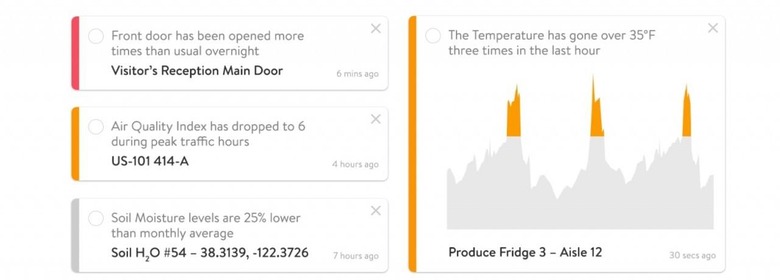Helium wants to be "the Android for IoT": Here's how
The Internet of Things is the Wild West, but startup Helium believes it has what it takes to act as sheriff. Instead of a gun and a horse, though, Helium is bringing the power of the cloud and a brand new, highly-flexible reprogrammable and wireless sensor to clean up, not to mention some big ambitions.
"We want to be the Android for IoT," president and COO Rob Chandhok told me when I caught up with the Helium team at the company's San Francisco HQ.
Chandhok left Qualcomm in late 2014, having most recently led the company's own IoT division, and joined Helium shortly after the company clinched a $16m Series A round.
According to Amir Haleem, CEO and co-founder, the initial motivation behind Helium was a little more conservative. "We're software people," he described himself and his friends to me, "we don't know anything at all about hardware, even less about radios."
Despite that, more and more of his peers were trying to implement their software in physical devices, and hitting a wall in the process. The goal, therefore, was "a way for our friends to build their products and businesses" without necessarily also needing to be electrical engineers.

The result is Helium the platform, consisting of physical sensors, the cloud with which they communicate, and the analytics that can be brought to bear on their data.
Part of the problem with the current state of the IoT, as Chandhok knows from long experience, is that the creation of embedded devices generally starts from fresh code up. That's not something most modern developers are used to, and it's all too often time-consuming, expensive, and generally wasteful.
"If you start a new application in the cloud, you never start from scratch," he pointed out to me. "You stand on Ruby on Rails, or Node.JS, etc."
Helium, in contrast, begins with a reprogrammable sensor. Internally codenamed Isotope, it consists of a mainboard with a low-power processor, 802.154 wireless on the 2.4 GHz and 900 MHz bands to avoid WiFi and Bluetooth congestion, and a key-store chip that holds a unique ID assigned at manufacture.
On top of that board fits your choice of sensor. Initially, that's a temperature probe and a magnetic switch that can tell if a door is opened or closed, but it's designed from the outset with the goal that third-party sensor makers could slap on their own hardware.

Much of what Helium has done with its sensors is about making them simple to program for and deploy. For a start they're frugal – Chandhok estimates 1-2 years of use out of a pair of AA batteries, depending on how often they ping the cloud – and each is Helium-certified to international standards so that things like lab temperature monitoring shouldn't run into any regulatory barriers.
Most unlike traditional embedded platforms, however, is that they can be taught new tricks. Rather than coming up with the final code, flashing the hardware, and hoping you thought of everything in advance, Helium developers will be able to write software "in a language you can't screw up," Chandhok promises, and then push out updates and tweaks wirelessly, whether you've deployed one Isotope or 10,000 of them.
"Imagine if every iOS developer had to write their own app updating mechanism," Chandhok observed, likening that the current state of play of embedded systems.
"We're not actually sure what people will do with it," he admitted to me, that being one of the most appealing aspects of rapidly iterating in a software-centric way even though you're dealing with hardware.
The fallout from getting embedded systems wrong can be significant, too. Chandhok's example is a case from Stanford Children's Health center earlier this year, which had to repeat the vaccinations of more then 1,500 people after discovering that the medication had routinely been falling below freezing point.
The monitoring, Chandhok pointed out, was designed with extreme high temperatures in mind, but hadn't taken into account that extreme lows could be just as dangerous. "It wasn't smart enough," he says.
Wireless sensors are only part of Helium's charm, however. The other component is in the cloud, where each Isotope sends its data, is remotely managed, and the analytics take place.

"A lot of the people with expertise at IoT – with all due respect – really suck at user experience," Chandhok jokes, and so Helium's UX is designed to be both approachable and flexible. For a start it uses modern web APIs, so there's no complicated translation between the data being gathered and any iOS, Android, or web apps being used to monitor it.
At the same time, it's designed to deal with sensors over their entire lifespan, and at huge scale. Everything fed back from the Isotope – whether the results of its probes or the voltage of its batteries – can be looked at individually, or alternatively only the outliers, with a simple wizard to create rules.
That can be something simple, like firing out a text message or updating a Slack channel when a particular door is opened, but it can be complex too, like "if opened X times within Y minutes, then Z." If you're more confident with the code, you can bypass the UI altogether and establish rules manually, and similarly all sensor data can be extracted with JSON.
That freedom to access information is a key motivation of Helium's, with Chandhok explaining how frustrating he finds the current consumer IoT. Calling out Nest, for instance – the smart thermostat of which he owns – he points out that while it's packed with sensors, the Google-owned company won't give him access to any of them.
"I don't mind paying for it," Chandhok says, "I just don't understand why I can't get my data."

Helium's initial target is the enterprise, neatly bypassing the current standards war in domestic IoT around things like HomeKit, Thread, and other platforms. All the same, I can see how the reprogrammable sensors and easy web interface could be appealing to individuals as a more flexible alternative to products like SmartThings and IFTTT.
Consumers would have as much to benefit from Helium's baked-in security and its cloud's ability to intelligently drop duplicate data from overlapping sensors. Indeed, another of the startup's ambitions – a marketplace of algorithms with which to process and understand the sensor data, such as predicting when a fridge compressor might be set to fail from the fluctuations in temperature – could just as readily offer home automation, security, and convenience functionality for individual users.
That'll have to wait a while, and though Helium is launching for enterprise now, individual sensor pricing hasn't been decided. Instead, the expectation is that "sensing as a service" will be the more popular route, with companies paying per sensor, per month rather than a big upfront fee.
It's ambitious, but Helium is counting on its flexibility and the reassurance of being able to retroactively fix errors and omissions that could be hugely costly with traditional embedded platforms. "We're providing a set of tools that are unusual for this world," Haleem he concludes. "It's very difficult to back-post things that you didn't include in the first place."
MORE Helium
